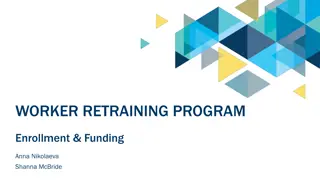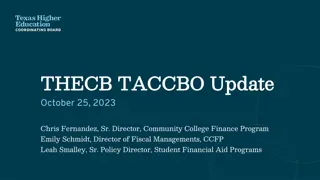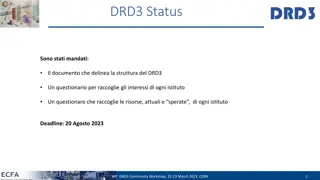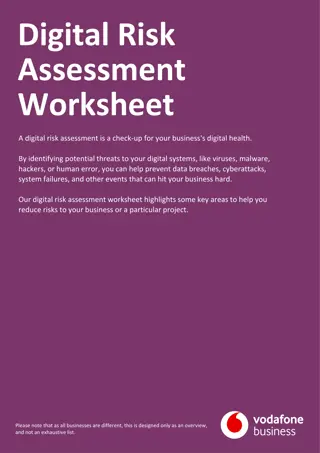Guide to Securing Funding for Your Business
Learn how to secure financial resources, determine funding needs, and weigh the pros and cons of different funding sources such as personal savings, loans, venture capital firms, and private equity. Understand the types of debt financing and stock financing available. Explore the advantages and disadvantages of high and low financing options, and the stages of accessing funding from seed capital to long-term bank loans. Plus, grasp the definitions of venture capital and private equity firms and why investors invest in startups.
Download Presentation

Please find below an Image/Link to download the presentation.
The content on the website is provided AS IS for your information and personal use only. It may not be sold, licensed, or shared on other websites without obtaining consent from the author. Download presentation by click this link. If you encounter any issues during the download, it is possible that the publisher has removed the file from their server.
E N D
Presentation Transcript
CHAPTER 9 Secure Funding
YOU SHOULD KNOW : - How to secure financial resources - The steps you must take to determine the funding you need to raise. -Understand the pros and cons of using your. personal money - The pros and cons of raising money from family and friends
-why angle investors invest in unknown start-up companies -why privet equity investors invest in small companies -The types of debt financing ; secured and unsecured loans . -The pros and cons of stock financing .
UNIT 1 HOW TO ACCESS FUNDING **Easy to access (sources of fund): -Your Personal saving . -Your Personal loan . -Your Personal productive assets. -Money from Relative . -Money from friends. **Difficult to access: -Venture Capital firms . -Venture Capital funds . -Private equity firms. -Bank loans.
UNIT 1 HOW TO ACCESS FUNDING Conception to newborn seed capital Infancy to childhood venture capital Childhood to teenage private equity Teenage to maturity short term bank loans, stock financing Maturity long term bank loans, bonds
SIZE OF THE INITIAL FINANCING First : The more money you can raise at the beginning ,the better. Second : The case of early financing ,less is better .
HIGH / LOW FINANCING *Advantages *Disadvantages
HIGH FINANCING Advantages Disadvantages Permits to survive Much money/ may spend it unwisely Flexibility Avoid borrowing from suppliers and banks Security
LOW FINANCING Advantages Disadvantages Limited capitalization prevents losses You may give up control/or a piece of the business Keep attentions on principal objectives Keep the value of your business
DEFINITIONS Venture capital firm: a company that channels investments to new venture. Private equity firms: Firms that direct investments into young and promising private companies. the aim is to capture the high-growth stage in young companies. Venture capital firm: Money that assembled for the purpose of investing in new venture.
STEPS FROM START TO FINISH What you need??
paying back the money What offers you can give Proving your company to the investor Convincing the investor How much money you need to start ???
SOURCE OF FUNDING Private Companies Your Saving Government Agencies Your Family Angel investors Your friends and Colleagues Venture Capitalists Banks
UNIT 2 WHERE TO ACCESS FUNDING 1- Personal money. 2- Family . 3- Friends . 4- Angel investor . 5- venture capital .
DEFINITIONS Personal Money Examples Savings Mortgage your home. Buy raw materials using credit card Sell an item of value to raise cash.
PERSONAL FINANCE Advantages Disadvantages Easy to manage You may need more. No need to wait long Family mat suffer No to convince other people High risk Simple accounting process You do not owe anybody.
DEFINITIONS Mortgage A loan based on the value of your house or your land. Bankruptcy A declaration that the company is unable to pay back its loans Equity Ownership or part ownership Angel Investor (freelance venture capitalist) A rich individual who invests in early-stage companies in exchange for equity ownership in the business
Angel Investor freelance venture capitalist A primary source of capital among early-stage companies. Do not belong to association or trade (like bank or venture capitalist).
Equity Capital: public and private Private Equity: late and early stage Venture Capital (early stage): Individual and institutional Angel Investor: Individuals in early- stage venture capital
Question 2: What kind of funding sources in your company ??
UNIT 3 TYPES OF CAPITAL There are two major types of capital: sources of funds Type of capital Characteristics Debt Bank loans They have the legal priority of getting paid a profit-sharing fee , or getting their money back if any thing goes wrong . Paid back after the bank fully paid . Loans from investors subordinate
Equity Preferred shares They have the fixed annual dividend . They don t have the rights of voting . Common shares The value of the common shares can go up over time . They have the right of voting . Common shareholders are decision makers and members of the board.
BANKING AND LENDING INSTITUTION * They are not risk taker . They don t like to lend money to start- up businesses . They classified as the most impersonal sources of funds .
STOCK FINANCING The pose and cons of financing with common stock : Advantages Disadvantages Don t make dividend payment to stockholders . Corporate voting Improves the credit rating. Shareholders can share in the profits for many years Attractive to some investors .
SELLING SHARES Advantages Disadvantages Raise long-term money. Its like cutting down a newly plan tree. You don t have to pay cash dividends every year. Facing bad investors in directing once your company gets started . TA: Maha Alzailai MGT Department

















































